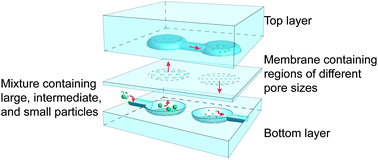Particle sorting using a porous membrane in a microfluidic device†
Abstract
Porous membranes have been fabricated based on the development of the perforated membrane mold [Y. Luo and R. N. Zare, Lab Chip, 2008, 8, 1688–1694] to create a single filter that contains multiple pore sizes ranging from 6.4 to 16.6 µm inside a monolithic three-dimensional poly(dimethylsiloxane) microfluidic structure. By overlapping two filters we are able to achieve smaller pore size openings (2.5 to 3.3 µm). This filter operates without any detectable irreversible clogging, which is achieved using a cross-flow placed in front of each filtration section. The utility of a particle-sorting device that contains this filter is demonstrated by separating polystyrene beads of different diameters with an efficiency greater than 99.9%. Additionally, we demonstrate the effectiveness of this particle-sorting device by separating whole blood samples into white blood cells and red blood cells with platelets.


 Please wait while we load your content...
Please wait while we load your content...